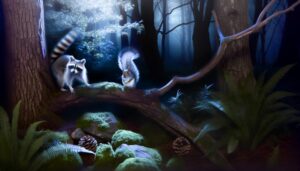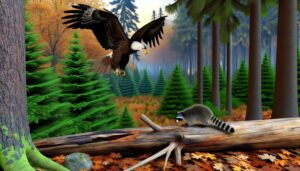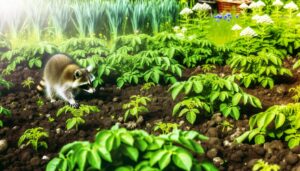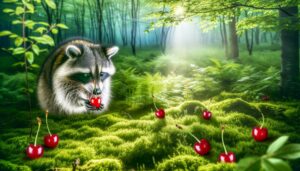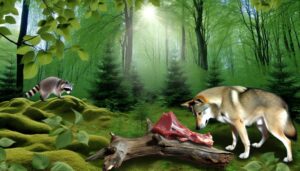How Does a Raccoon Eat Grass?
Raccoons exhibit a highly omnivorous and opportunistic diet, mainly consuming invertebrates, plant materials, and vertebrates. Grass consumption by raccoons is infrequent and constitutes a minor component, often less than 5% of their diet.
While low in nutritional value, grass aids in digestion through dietary fiber intake and assists gastrointestinal motility. It is typically ingested during food scarcity or for digestive health.
Environmental factors and dietary needs can prompt raccoons to consume grass, alongside fruits, insects, and small animals. Continue exploring to understand the ecological adaptability of raccoons and their versatile dietary habits.
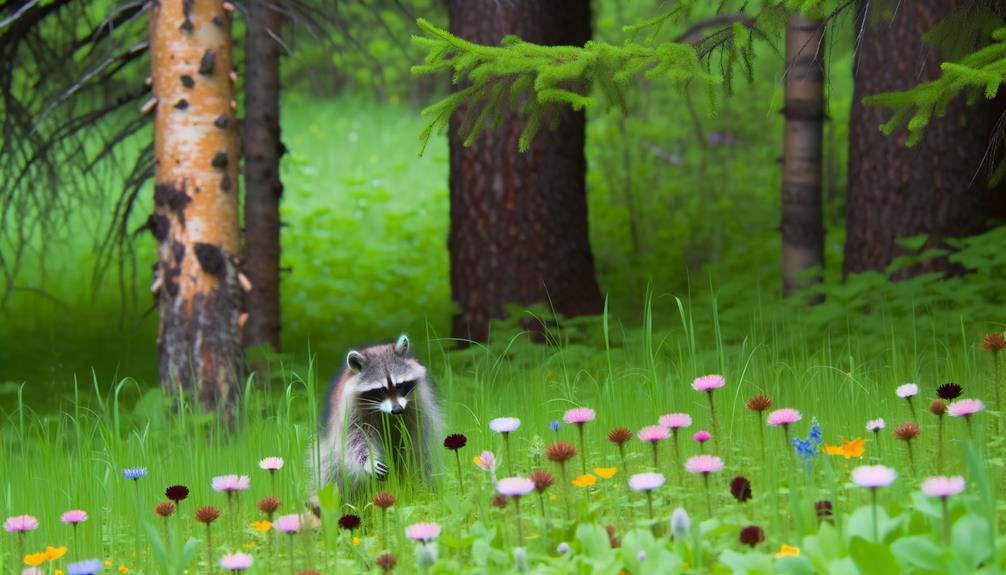
Key Takeaways
- Raccoons occasionally consume grass, typically less than 5% of their diet.
- Grass consumption aids digestion by providing dietary fiber.
- Ingesting grass can help expel indigestible materials from their gastrointestinal tract.
- Grass may help manage intestinal parasites by inducing vomiting or increasing fiber intake.
- Grass consumption is incidental and driven by food scarcity or digestive disturbances.
Raccoon Diet Overview
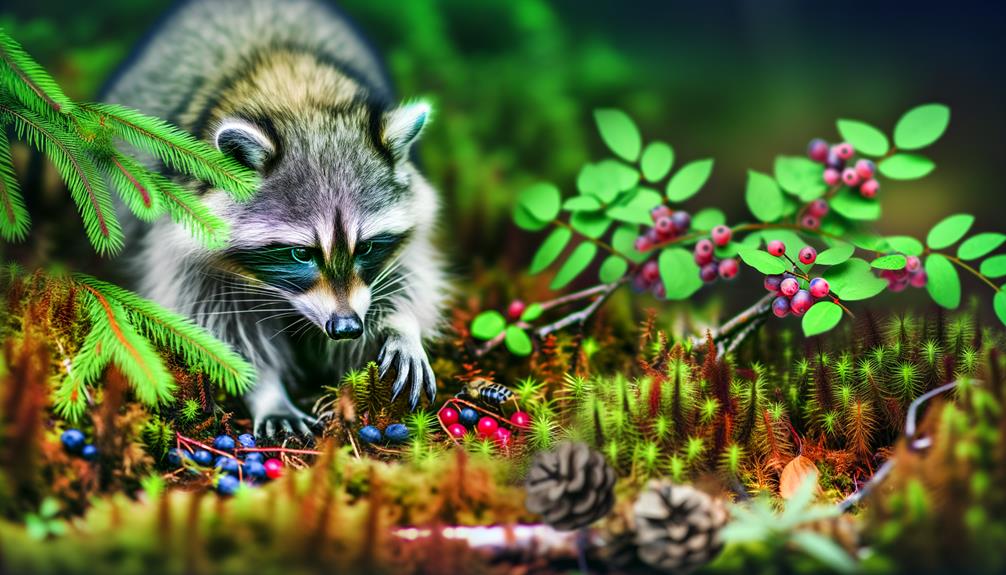
A raccoon's diet is highly omnivorous and opportunistic, consisting of a wide variety of both animal and plant matter. According to studies, Procyon lotor consumes approximately 40% invertebrates, 33% plant material, and 27% vertebrates.
Seasonal variations significantly influence dietary choices, with invertebrates such as insects and crayfish dominating in spring and summer, while mast, fruits, and nuts are prevalent in autumn. Vertebrate consumption includes small mammals, birds, and amphibians.
Urban raccoons often exploit anthropogenic food sources, including garbage and pet food. Nutritional intake is influenced by habitat and availability, demonstrating the species' adaptive foraging strategies.
This dietary flexibility supports raccoons' survival across diverse ecosystems, from woodlands to urban areas, highlighting their ecological adaptability.
Omnivorous Nature
Raccoons exhibit omnivorous feeding behaviors, characterized by a broad spectrum of dietary preferences that include both animal and plant-based sources. Research indicates that their diet encompasses fruits, nuts, insects, and small vertebrates, demonstrating their adaptability in various environments.
Additionally, plant-based consumption, such as berries and nuts, constitutes a significant portion of their nutritional intake, underscoring their versatile foraging strategies.
Diverse Dietary Preferences
Exhibiting a highly adaptable omnivorous nature, Procyon lotor demonstrates dietary flexibility by consuming a wide array of both plant and animal matter, including fruits, insects, and small vertebrates. This dietary adaptability is supported by observational data, revealing that raccoons adjust their food intake based on seasonal availability and habitat.
For instance, in urban environments, they exploit anthropogenic food sources such as garbage and pet food, while in rural settings, their diet may include corn, crayfish, and amphibians. Studies indicate that raccoons possess a generalized dentition and digestive system, enabling efficient processing of diverse nutrients.
Their opportunistic feeding habits not only enhance survival but also influence ecosystem dynamics by contributing to seed dispersal and controlling insect populations.
Plant-Based Consumption
Raccoons' omnivorous diet includes a significant portion of plant-based foods, such as fruits, nuts, and grains, which they consume alongside animal matter to meet their nutritional requirements. Studies have demonstrated that plant-based consumption constitutes approximately 40% of their overall diet. This dietary flexibility allows raccoons to thrive in diverse habitats, from urban areas to dense forests.
Seasonal variations influence their plant-based intake, with a higher consumption of fruits and berries during summer and fall. Additionally, raccoons exhibit foraging behaviors that optimize nutrient intake, selectively choosing high-caloric and nutrient-dense plant matter.
While grass is occasionally ingested, it is not a primary food source, serving more as an incidental or supplementary component to their broader dietary regimen.
Typical Urban Foods

In urban environments, the diet of raccoons often includes a range of anthropogenic food sources such as discarded fast food, pet food, and household waste. These food items provide high-caloric intake but are generally low in nutritional quality. Raccoons exhibit opportunistic feeding behavior, frequently scavenging through garbage bins and exploiting easily accessible pet food.
| Food Source | Nutritional Value |
|---|---|
| Discarded Fast Food | High Calories, Low Nutrients |
| Pet Food | Balanced Nutrients |
| Household Waste | Variable Quality |
This reliance on human-derived food sources can lead to increased health issues in raccoons, such as obesity and dental problems. The urban diet reflects both the adaptability and the potential health risks for raccoons living in close proximity to human populations.
Wild Foraging Habits
Raccoons exhibit a diverse foraging strategy in wild habitats, primarily consuming fruits, nuts, insects, and small vertebrates. Grass consumption is infrequent and generally occurs as a supplementary food source.
Seasonal variations notably influence their dietary patterns, with a marked increase in the intake of specific food types during periods of abundance.
Typical Diet Components
Characterized by their omnivorous feeding behavior, raccoons exhibit a diverse diet that includes fruits, nuts, insects, small mammals, and occasionally plant matter such as grass. Studies have shown that raccoons adapt their foraging strategies to seasonal availability, consuming more fruits and nuts during autumn and shifting to insects and small vertebrates in spring and summer.
Examination of raccoon scat samples reveals an opportunistic feeding pattern, with diet composition varying considerably based on regional ecosystem and resource abundance. Additionally, raccoons demonstrate nocturnal foraging, utilizing their tactile sensitivity to locate food items.
This dietary plasticity underscores their ability to thrive in various habitats, ranging from urban settings to dense woodlands, thereby highlighting their ecological adaptability and resilience.
Occasional Grass Consumption
While raccoons primarily consume a varied diet, occasional ingestion of grass has been documented, potentially serving as a supplementary source of fiber or aiding in digestive processes.
Observational studies and scat analyses reveal that grass comprises a minor component of the raccoon diet, with instances varying geographically and seasonally.
The exact frequency and quantity of grass consumption remain under-researched, yet anecdotal evidence suggests it is not a regular dietary staple.
The ingestion of grass may function to alleviate gastrointestinal discomfort or assist in the expulsion of hairballs and other indigestible materials.
Further empirical research is required to quantify this behavior and elucidate its physiological benefits, if any, within the broader scope of raccoon foraging habits.
Seasonal Foraging Behavior
Seasonal variations greatly influence foraging behavior, with raccoons adjusting their diet based on the availability of food resources in their environment. This adaptive strategy guarantees their survival and reproductive success across different seasons.
During spring and summer, raccoons primarily consume:
- Insects: Abundant and high in protein.
- Fruits and berries: Provide essential vitamins and carbohydrates.
- Small mammals: Serve as a significant protein source.
- Bird eggs: Nutrient-dense and relatively easy to procure.
- Aquatic organisms: Crayfish and amphibians are frequently consumed.
In contrast, the fall season sees an increase in the consumption of nuts and seeds, which are rich in fats essential for winter energy reserves. Winter diets consist largely of any remaining autumnal resources and carrion, reflecting the scarcity of fresh food.
Seasonal Diet Changes
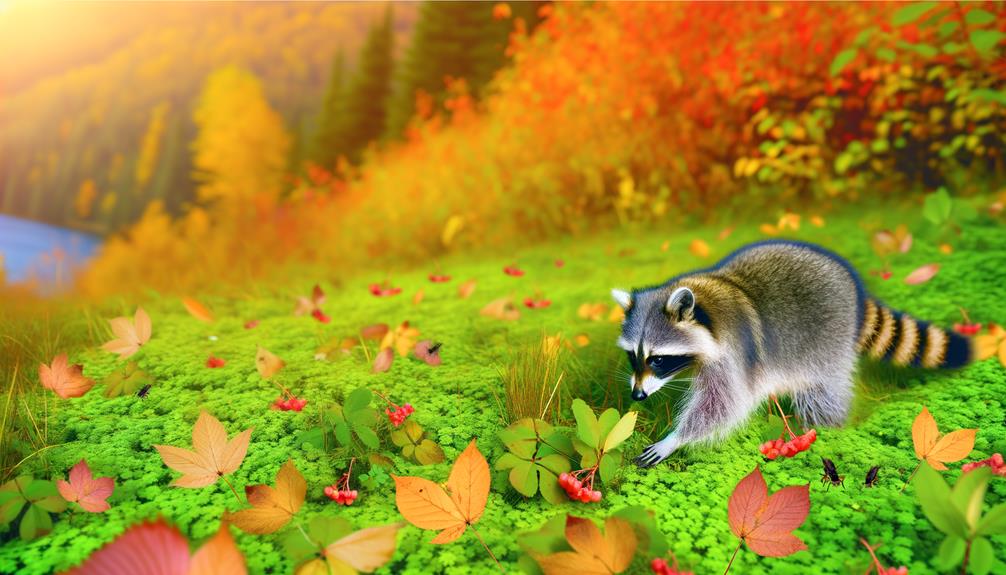
Raccoons exhibit notable dietary adaptations throughout the year, driven by the availability of resources and their physiological needs. During spring and summer, their diet mainly consists of fruits, berries, and insects, which are abundant and provide essential nutrients for growth and energy. In contrast, the fall season sees a shift towards nuts and acorns, crucial for fat accumulation in preparation for winter. Winter imposes a scarcity of food sources, prompting raccoons to rely on stored fat and scavenge for any available sustenance, including small animals and human refuse.
| Season | Primary Food Sources |
|---|---|
| Spring | Fruits, Berries, Insects |
| Fall | Nuts, Acorns |
| Winter | Stored Fat, Small Animals |
Such seasonal dietary shifts underscore the raccoon's adaptability to environmental changes.
Nutritional Needs
Understanding the nutritional needs of raccoons is essential for comprehending how their diet supports various physiological functions throughout different seasons. Raccoons, being omnivorous, require a balanced intake of macronutrients and micronutrients to maintain health and energy levels.
Their diet must provide:
- Proteins: Essential for muscle repair and enzyme functions.
- Fats: Necessary for energy storage and insulation.
- Carbohydrates: Primary energy source, especially during colder months.
- Vitamins: Needed for metabolic processes; e.g., Vitamin A for vision.
- Minerals: Important for bone health and enzyme activity.
Studies indicate that raccoons' dietary flexibility enables them to adapt to varied ecosystems, ensuring survival and reproductive success. This adaptability highlights the importance of understanding their specific nutritional requirements.
Grass Consumption Facts
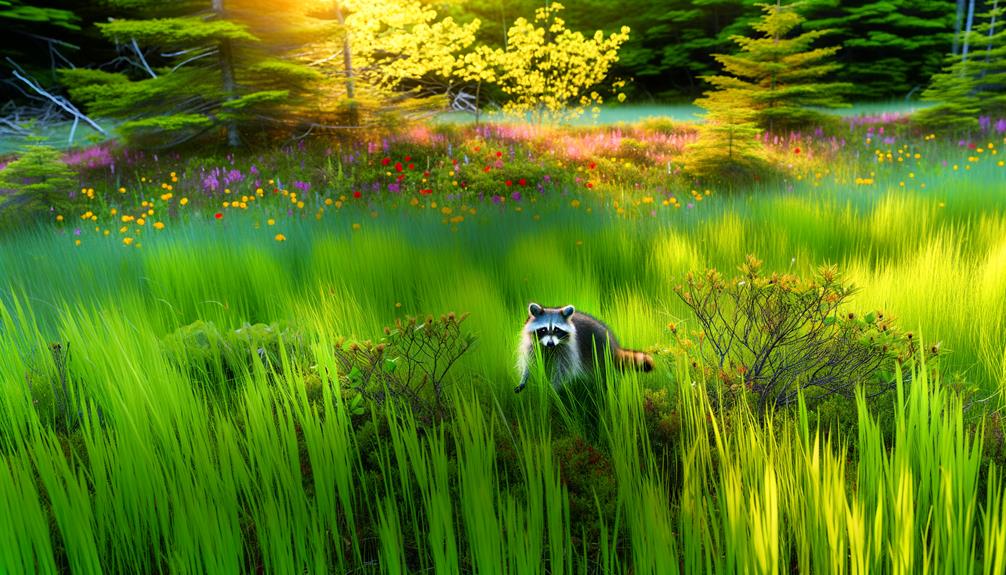
While primarily omnivorous, raccoons exhibit occasional grass consumption, which can be attributed to its role in aiding digestion through the intake of dietary fiber. Scientific observations indicate that grass constitutes a minor component of their diet, typically less than 5%.
This behavior is hypothesized to facilitate gastrointestinal motility and expulsion of indigestible materials. Raccoons have been noted to ingest grass more frequently during periods of food scarcity or when experiencing digestive disturbances. Analysis of raccoon scat samples further supports this behavior, revealing sporadic presence of grass fibers.
Despite its limited nutritional value, grass serves a functional purpose in the raccoon's digestive health, underscoring the adaptive versatility of their feeding habits. This secondary consumption reflects their dietary opportunism and ecological adaptability.
Plant-Based Foods
Raccoons exhibit occasional herbivorous behavior by consuming a variety of plant-based foods, including fruits, nuts, and vegetables. These foods provide essential nutrients such as vitamins, minerals, and dietary fiber, contributing to their overall health.
Data from observational studies indicate that raccoons incorporate plant matter into their diet seasonally, reflecting availability and nutritional needs.
Common Plant-Based Foods
A diverse array of plant-based foods constitutes a significant portion of a raccoon's diet, including fruits, nuts, seeds, and certain types of vegetables. These omnivorous mammals exhibit a preference for readily available and nutritionally dense plant matter. Research indicates that the following plant-based items are commonly consumed by raccoons:
- Fruits: Apples, berries, and grapes
- Nuts: Acorns and walnuts
- Seeds: Sunflower seeds and birdseed
- Vegetables: Corn and root vegetables
- Other Plant Matter: Grasses and leaves
These foods provide essential nutrients that support their physiological functions and energy requirements. Field studies and observational data corroborate the inclusion of these plant-based items, highlighting their importance in the raccoon's dietary habits.
Nutritional Benefits Overview
Understanding the nutritional benefits of plant-based foods in a raccoon's diet reveals important insights into their role in maintaining peak health and energy levels. Plant-based foods such as fruits, vegetables, and nuts are rich in essential vitamins, minerals, and dietary fibers. These nutrients support various physiological functions, including immune system enhancement and digestive efficiency.
For instance, fruits are a significant source of vitamin C and antioxidants, which can mitigate oxidative stress. Vegetables provide necessary micronutrients like potassium and magnesium, vital for metabolic processes. Additionally, dietary fiber from plant matter aids in gastrointestinal motility and overall gut health.
Consequently, integrating plant-based foods into a raccoon's diet contributes significantly to their nutritional adequacy and physiological resilience.
Occasional Herbivorous Behavior
While the nutritional benefits of plant-based foods in a raccoon's diet have been established, it is also pertinent to examine their occasional herbivorous behavior and the specific types of plant matter they consume.
Raccoons, though primarily omnivorous, exhibit periods of herbivory, particularly when animal-based foods are scarce. Studies indicate that raccoons consume the following plant-based items:
- Fruits: including berries, apples, and grapes, which provide essential vitamins and sugars.
- Nuts and seeds: offering necessary proteins and fats.
- Vegetables: such as corn and leafy greens, contributing fiber and minerals.
- Grasses and herbs: occasionally ingested, although not a primary food source.
- Roots and tubers: which are rich in carbohydrates and provide energy.
These dietary choices reflect raccoons' adaptability and opportunistic feeding strategies.
Role of Grass
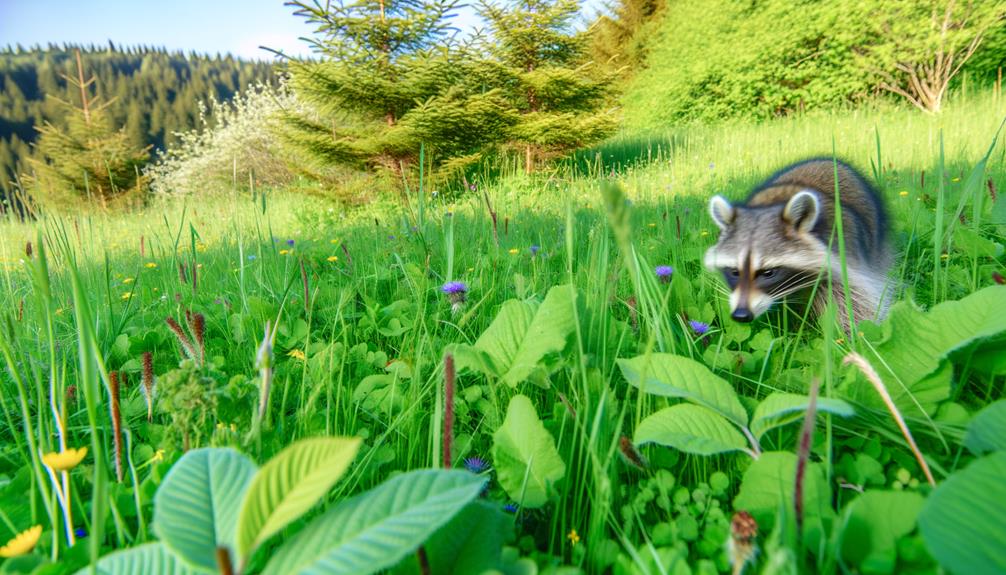
Functioning primarily as a supplementary food source, grass plays a minor role in the diet of raccoons, which are omnivorous and primarily consume a variety of other foods such as fruits, insects, and small animals. The nutritional content of grass offers limited caloric value compared to their primary dietary constituents. However, it can occasionally be ingested, especially when other food sources are scarce.
| Dietary Component | Primary Role in Diet |
|---|---|
| Fruits | Major source of vitamins |
| Insects | Protein and fat intake |
| Small Animals | Essential proteins and fats |
| Grass | Supplementary, limited value |
Understanding the role of grass in the raccoon's diet reveals the adaptive versatility of these animals in diverse ecological niches.
Grass Digestibility
Despite grass being a minor component in the raccoon's diet, its digestibility is limited due to the raccoon's comparatively simple digestive system, which lacks the specialized enzymes required to efficiently break down cellulose. Consequently, raccoons derive minimal nutritional value from grass.
Key factors impacting grass digestibility in raccoons include:
- Enzymatic limitations: Absence of cellulase enzyme.
- Digestive tract structure: Shorter, less complex gut.
- Fermentation process: Insufficient time for microbial fermentation.
- Nutrient absorption: Inability to extract essential nutrients from cellulose.
- Dietary preferences: Mainly omnivorous diet favoring more digestible foods.
Understanding these factors elucidates why grass consumption remains incidental rather than integral to the raccoon's dietary habits, underscoring their reliance on more diverse and nutrient-rich food sources.
Observational Studies
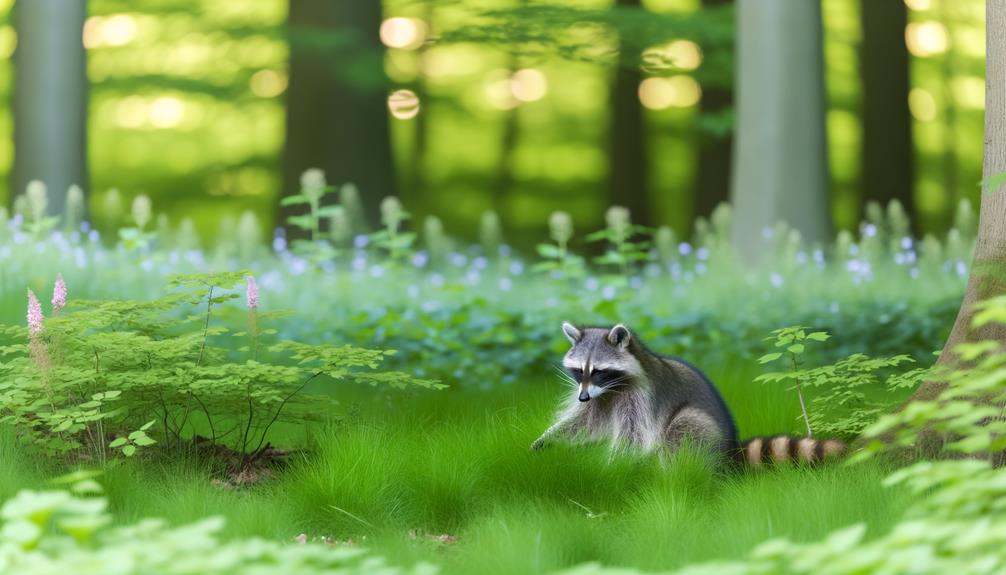
Recent observational studies have provided valuable insights into the dietary habits of raccoons, particularly regarding their occasional grass consumption. Utilizing methodologies such as direct observation and camera traps, researchers have documented instances of raccoons ingesting grass in various habitats. Data indicate that grass consumption is infrequent and typically occurs in conjunction with other dietary components.
Quantitative analysis reveals that grass constitutes a minor portion of their overall diet, generally less than 5%. Behavioral observations suggest that grass ingestion may serve specific physiological functions, such as aiding digestion or expelling parasites. These findings contribute to a nuanced understanding of raccoon foraging behavior and highlight the importance of multi-faceted dietary strategies in omnivorous species.
Expert Insights
Building on the observational data, expert insights provide a deeper understanding of the physiological and ecological reasons behind raccoon's occasional grass consumption. Researchers have identified several factors contributing to this behavior:
- Nutritional Deficiencies: Grass may provide essential micronutrients absent in their primary diet.
- Digestive Aid: Grass consumption can facilitate the expulsion of indigestible material from their gastrointestinal tract.
- Behavioral Adaptation: Opportunistic feeding habits may drive raccoons to consume available vegetation.
- Parasitic Control: Ingesting grass might help manage intestinal parasites by inducing vomiting or increasing fiber intake.
- Hydration Source: During periods of water scarcity, grass can serve as an alternative hydration source.
These insights elucidate the multifaceted nature of raccoon's dietary choices, underscoring the complexity of their feeding ecology.
Conclusion
To sum up, the raccoon's diet, akin to a versatile tapestry, reflects its omnivorous nature and adaptability to diverse environments.
While primarily consuming fruits, insects, and small vertebrates, raccoons occasionally ingest grass, though it constitutes a minor portion of their diet. Grass consumption may be incidental or serve specific nutritional needs, yet its digestibility remains limited.
Observational studies and expert insights underscore the raccoon's dietary flexibility, further elucidating the intricate dynamics of its foraging behavior.

